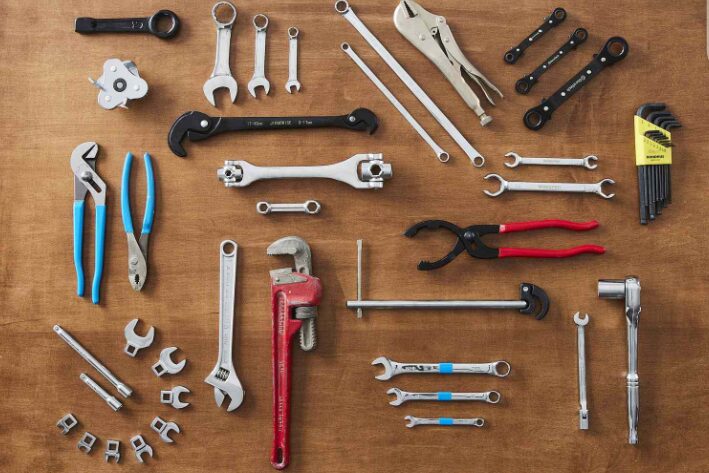When you’re working 40 feet up on a distribution pole with the Texas sun beating down on your back, the last thing you want is to fumble around with the wrong tool. As any seasoned lineman will tell you, having the right wrench for the job can mean the difference between wrapping up early and staying out until dark. Distribution linemen across the Lone Star State and beyond rely on specialized wrenches that are built tough, designed smart, and engineered to handle the unique challenges of utility work.
Understanding Distribution Lineman Wrenches: More Than Just Your Average Tool
Distribution lineman wrenches aren’t your grandfather’s toolbox staples. These specialized tools are purpose-built for the electrical utility industry, designed to handle the specific nuts, bolts, and hardware found on distribution poles. Unlike standard wrenches, these tools feature unique socket configurations that match the square nuts commonly used in utility applications.
The beauty of these specialized wrenches lies in their efficiency. Instead of carrying multiple tools up the pole, a lineman can grab one well-designed wrench that handles several different fastener sizes. This approach doesn’t just save space in your tool bag – it saves precious time when you’re working against the clock to restore power to a neighborhood.
Most distribution wrenches feature what’s called a “bolt-thru” design, which allows bolts to pass entirely through sockets and arm heads
. This innovative feature means nuts can be secured on any threaded length, giving linemen the flexibility they need when dealing with various hardware configurations on different pole types.
Double Square Distribution Wrenches: The Reliable Workhorses
Box Wrench technology really shines in double square distribution wrenches. These tools typically feature two square openings – commonly 13/16″ and 1″ – that handle the majority of distribution hardware you’ll encounter in the field
. The Lowell 150 and 151 models are popular choices among utility crews, offering ergonomic handles that reduce hand fatigue during long work sessions.
What makes double square wrenches particularly valuable is their compact design. When you’re already carrying climbing gear, safety equipment, and other essential tools, every ounce matters. These wrenches provide excellent functionality without the bulk of larger multi-socket designs.
The ergonomic handle shapes featured on modern double square wrenches make work significantly more comfortable
. After spending a career watching linemen develop repetitive stress injuries from poorly designed tools, manufacturers have finally caught on to the importance of comfort in tool design.
Triple Square Distribution Wrenches: The Sweet Spot for Most Jobs
For many distribution linemen, triple square wrenches represent the perfect balance between functionality and portability. The Lowell 151T model, for example, features three square openings: 3/4″, 1″, and 1-1/8″
. This distributor wrench configuration covers the three most common pole fasteners used by telephone, cable, and electrical utility companies.
The 151T features a semi-enclosed ratchet mechanism that speeds up repetitive tasks
. When you’re installing multiple pieces of hardware on a single pole, this ratcheting action can save significant time and reduce the arm fatigue that comes with manual turning of each fastener.
One standout feature of quality triple square wrenches is the fluorescent orange socket coloring
. While this might seem like a minor detail, anyone who’s dropped a tool from height knows how valuable visibility can be. These bright sockets make wrenches harder to lose and easier to spot if they do end up on the ground.
Quad Square Distribution Wrenches: Maximum Versatility
When versatility is paramount, quad square wrenches like the Lowell 8D model take center stage. These combination wrench tools feature four different square openings: 3/4″, 13/16″, 1″, and 1-1/8″
. The philosophy here is simple: carry one wrench instead of four.
The 8D model is particularly impressive with its range of applications. The 1-1/8″ square opening handles 3/4″ hardware, the 1″ square opening works with 5/8″ hardware, the 13/16″ square opening fits 1/2″ hardware, and the 3/4″ square opening accommodates 1/2″ lag bolts
. This comprehensive coverage means linemen can tackle virtually any fastener they encounter without heading back to the truck.
At just 1-3/8 pounds, these quad square wrenches prove that functionality doesn’t have to mean excessive weight
. For linemen who are already carrying substantial gear up every pole, this weight consideration becomes crucial for long-term career sustainability.
Battery Impact Wrenches: The Power Revolution
Battery Impact Wrench technology has revolutionized how linemen approach certain tasks. The Klein BAT20-7161 impact wrench delivers up to 500 ft-lbs of torque, making quick work of stubborn fasteners that would otherwise require significant manual effort
. Operating on the DeWALT battery platform, this tool provides the power of pneumatic tools without the need for air compressors or generators.
The variable speed trigger allows for precise control, while the safety lockout switch prevents accidental activation
. For line work applications, this wrench features a 7/16″ hex quick-change chuck and a lifting ring for easy transport on a handline
. This design consideration shows how manufacturers are finally understanding the unique transportation challenges linemen face.
Impact wrenches particularly shine when dealing with seized or corroded fasteners – a common challenge when working on infrastructure that may have been installed decades ago. The high torque output can break loose fasteners that would be nearly impossible to move with manual tools.
Adjustable Wrenches: Flexibility When You Need It
Sometimes the unexpected happens, and you encounter hardware that doesn’t fit your standard distribution wrenches. This is where a quality Adjustable Wrench becomes invaluable. The Channellock 810W offers wide jaws with up to 25% extra capacity compared to standard adjustable wrenches
.
The longer, thinner jaws provide better grip while offering superior access in tight spaces
. For linemen working in congested pole environments where space is at a premium, these design improvements can make challenging tasks manageable.
Laser-engraved measurement scales on both sides (inches on front, millimeters on reverse) add functionality for sizing nuts, pipes, and tube diameters
. This feature proves particularly useful when ordering replacement hardware or verifying specifications in the field.
Essential Features That Make the Difference
Ergonomic design isn’t just about comfort – it’s about career longevity. Quality distribution wrenches feature handle shapes that reduce stress on hands and wrists, critical considerations for professionals who use these tools daily. The combination of comfortable grips and efficient ratcheting mechanisms can significantly reduce the physical toll of repetitive tasks.
Chrome vanadium steel construction provides the durability needed for professional use while resisting corrosion
. When your tools are exposed to weather extremes and potentially corrosive environments, material quality becomes a crucial factor in tool longevity.
Made in USA manufacturing continues to be important for many utility companies and linemen. Domestic production often means better quality control, readily available replacement parts, and support for American manufacturing jobs
.
Choosing the Right Wrench for Your Needs
The choice between double, triple, or quad square wrenches often comes down to the specific type of work you perform most often. Distribution linemen working primarily with telephone and cable installations might find triple square wrenches ideal, while those dealing with a wider variety of utility infrastructure might prefer quad square models.
Consider your physical work environment as well. Linemen working in areas with frequent tool drops might prioritize lighter tools, while those dealing with stubborn or corroded hardware might invest in impact wrench technology.
Don’t forget about the importance of having backup tools. When you’re working on critical infrastructure, having redundant capabilities can prevent a simple tool failure from turning into an extended outage. Many experienced linemen carry both a multi-socket wrench for efficiency and a quality adjustable wrench for unexpected situations.
The Complete Lineman’s Toolkit
While specialized wrenches are crucial, they’re just one part of a complete lineman’s toolkit. Quality lineman apparel including lineman shirts , lineman pants , and lineman jackets provide the protection and functionality needed for safe, efficient work. Similarly, having reliable climbing gear, safety equipment, and communication tools rounds out the professional lineman’s kit.
The investment in quality lineman tools pays dividends throughout a career. Professional-grade distribution wrenches might cost more upfront, but their durability, efficiency, and ergonomic benefits make them worthwhile investments for serious linemen.
Conclusion
Distribution lineman wrenches represent decades of evolution in tool design, driven by the real-world needs of utility professionals. From basic double square designs to sophisticated battery-powered impact tools, today’s linemen have access to equipment that would have seemed revolutionary just a generation ago. The key is understanding your specific needs and choosing tools that enhance both efficiency and safety in your daily work. Whether you’re reaching for a tried-and-true triple square wrench or grabbing a high-torque impact driver for a stubborn bolt, having the right tool for the job makes all the difference in the world.
Frequently Asked Questions
Q1: What’s the difference between double, triple, and quad square distribution wrenches?
A: The main difference is the number of socket openings. Double square wrenches have two openings (typically 13/16″ and 1″), triple square wrenches have three (usually 3/4″, 1″, and 1-1/8″), and quad square wrenches have four different sized openings. More sockets mean greater versatility but potentially more weight and bulk.
Q2: Are battery impact wrenches worth the investment for distribution work?
A: Battery impact wrenches excel at removing seized or corroded fasteners and can significantly speed up repetitive tasks. They’re particularly valuable for linemen dealing with older infrastructure where manual removal might be difficult or impossible. The Klein BAT20-7161, for example, provides up to 500 ft-lbs of torque, making it suitable for most distribution applications.
Q3: Why is the “bolt-thru” design important in distribution wrenches?
A: Bolt-thru design allows bolts to pass completely through the socket and arm head, enabling nuts to be secured on any threaded length. This flexibility is crucial when working with various hardware configurations and eliminates the frustration of discovering your bolt is too long for your wrench socket.
Q4: How do I maintain my distribution wrenches for maximum longevity?
A: Regular cleaning, proper storage, and periodic lubrication of ratcheting mechanisms are essential. Chrome vanadium steel tools resist corrosion naturally, but keeping them clean and dry extends their life. Store wrenches in a organized manner to prevent damage from tools banging against each other during transport.
Q5: What should I look for when buying distribution wrenches as a new lineman?
A: Focus on ergonomic handles, quality steel construction (preferably chrome vanadium), and reputable manufacturers like Lowell or Klein. Consider starting with a triple square wrench as it covers the most common applications, then add specialized tools as your experience and specific job requirements dictate. Made in USA tools often provide better long-term value and support.





























